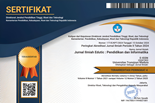Inovasi Model Intrusion Detection System (IDS) menggunakan Double Layer Gated Recurrent Unit (GRU) dengan Fitur Berbasis Fusion
Abstract
Intrusion Detection System (IDS) merupakan komponen penting dalam menjaga keamanan jaringan dari ancaman siber. Dengan meningkatnya jumlah dan kompleksitas serangan, diperlukan metode deteksi yang lebih akurat dan efisien. Dalam penelitian ini, diusulkan model IDS berbasis Double Layer Gated Recurrent Unit (GRU) yang dirancang untuk meningkatkan akurasi deteksi dan mengurangi kesalahan prediksi. Arsitektur GRU ganda memungkinkan pengambilan fitur temporal yang lebih baik dari data lalu lintas jaringan. Model ini diuji menggunakan dataset standar IDS, dan hasil eksperimen menunjukkan bahwa metode ini mampu mencapai tingkat akurasi yang lebih tinggi dibandingkan dengan model GRU tunggal dan metode pembelajaran mesin konvensional. Selain itu, penerapan proses feature fusion di antara dua lapisan GRU memberikan kontribusi signifikan terhadap peningkatan akurasi dan pengurangan tingkat false positive rate (FPR). Temuan ini mengindikasikan bahwa arsitektur yang diusulkan efektif dalam mendeteksi serangan jaringan secara real-time dengan efisiensi komputasi yang lebih baik.
Keywords
Full Text:
PDFReferences
Al-Kahtani, Mohammad S., Zahid Mehmood, Tariq Sadad, Islam Zada, Gauhar Ali, and Mohammed Elaffendi. 2023. “Intrusion Detection in the Internet of Things Using Fusion of GRU-LSTM Deep Learning Model.” Intelligent Automation and Soft Computing 37(2):2279–90. doi: 10.32604/iasc.2023.037673.
Alzahrani, Ali, and Theyazn H. H. Aldhyani. 2023. “Design of Efficient Based Artificial Intelligence Approaches for Sustainable of Cyber Security in Smart Industrial Control System.” Sustainability (Switzerland) 15(10). doi: 10.3390/su15108076.
Ashraf, Imran, Manideep Narra, Muhammad Umer, Rizwan Majeed, Saima Sadiq, Fawad Javaid, and Nouman Rasool. 2022. “A Deep Learning-Based Smart Framework for Cyber-Physical and Satellite System Security Threats Detection.” Electronics (Switzerland) 11(4):1–15. doi: 10.3390/electronics11040667.
Azar, Ahmad Taher, Esraa Shehab, Ahmed M. Mattar, Ibrahim A. Hameed, and Shaimaa Ahmed Elsaid. 2023. Deep Learning Based Hybrid Intrusion Detection Systems to Protect Satellite Networks. Vol. 31. Springer US.
Azizan, Adnan Helmi, Salama A. Mostafa, Aida Mustapha, Cik Feresa Mohd Foozy, Mohd Helmy Abd Wahab, Mazin Abed Mohammed, and Bashar Ahmad Khalaf. 2021. “A Machine Learning Approach for Improving the Performance of Network Intrusion Detection Systems.” Annals of Emerging Technologies in Computing 5(Special issue 5):201–8. doi: 10.33166/AETiC.2021.05.025.
Barkah, Azhari Shouni, Siti Rahayu Selamat, Zaheera Zainal Abidin, and Rizki Wahyudi. 2023. “Impact of Data Balancing and Feature Selection on Machine Learning-Based Network Intrusion Detection.” International Journal on Informatics Visualization 7(1):241–48. doi: 10.30630/joiv.7.1.1041.
Bingu, Rajesh, and S. Jothilakshmi. 2023. “Design of Intrusion Detection System Using Ensemble Learning Technique in Cloud Computing Environment.” International Journal of Advanced Computer Science and Applications 14(5):751–64. doi: 10.14569/IJACSA.2023.0140580.
Cao, Bo, Chenghai Li, Yafei Song, Yueyi Qin, and Chen Chen. 2022. “Network Intrusion Detection Model Based on CNN and GRU.” Applied Sciences (Switzerland) 12(9). doi: 10.3390/app12094184.
Chung, Junyoung. n.d. “Gated Recurrent Neural Networks on Sequence Modeling ArXiv : 1412 . 3555v1 [ Cs . NE ] 11 Dec 2014.” 1–9.
Gautam, Sunil, Azriel Henry, Mohd Zuhair, Mamoon Rashid, Abdul Rehman Javed, and Praveen Kumar Reddy Maddikunta. 2022. “A Composite Approach of Intrusion Detection Systems: Hybrid RNN and Correlation-Based Feature Optimization.” Electronics (Switzerland) 11(21). doi: 10.3390/electronics11213529.
Hanafi, Hanafi, Andri Pranolo, Yingchi Mao, Taqwa Hariguna, Leonel Hernandez, and Nanang Fitria Kurniawan. 2023. “IDSX-Attention: Intrusion Detection System (IDS) Based Hybrid MADE-SDAE and LSTM-Attention Mechanism.” International Journal of Advances in Intelligent Informatics 9(1):121–35. doi: 10.26555/ijain.v9i1.942.
Hanafi, Alva Hendi Muhammad, Ike Verawati, and Richki Hardi. 2022. “An Intrusion Detection System Using SDAE to Enhance Dimensional Reduction in Machine Learning.” International Journal on Informatics Visualization 6(2):306–16. doi: 10.30630/joiv.6.2.990.
Isife, Olisaemeka F., Kennedy Okokpujie, Imhade P. Okokpujie, Roselyn E. Subair, Akingunsoye Adenugba Vincent, and Morayo E. Awomoyi. 2023. “Development of a Malicious Network Traffic Intrusion Detection System Using Deep Learning.” International Journal of Safety and Security Engineering 13(4):587–95. doi: 10.18280/ijsse.130401.
Kalimuthu, Vinoth Kumar, and Rajakani Velumani. 2024. “Modeling of Intrusion Detection System Using Double Adaptive Weighting Arithmetic Optimization Algorithm with Deep Learning on Internet of Things Environment.” Brazilian Archives of Biology and Technology 67. doi: 10.1590/1678-4324-2024231010.
Kilichev, Dusmurod, Dilmurod Turimov, and Wooseong Kim. 2024. “Next–Generation Intrusion Detection for IoT EVCS: Integrating CNN, LSTM, and GRU Models.” Mathematics 12(4). doi: 10.3390/math12040571.
Merri, Bart Van, and Cifar Senior Fellow. 2014. “Learning Phrase Representations Using RNN Encoder – Decoder for Statistical Machine Translation.” 1724–34.
Odeh, Ammar, and Anas Abu Taleb. 2023. “Ensemble-Based Deep Learning Models for Enhancing IoT Intrusion Detection.” Applied Sciences (Switzerland) 13(21). doi: 10.3390/app132111985.
Shankar, D., G. Victo Sudha George, and N. Kanya. 2023. “OptiBiNet_GRU: Robust Network Intrusion Detection System Using Optimum Bi-Directional Gated Recurrent Unit.” International Journal of Intelligent Engineering and Systems 16(3):75–91. doi: 10.22266/ijies2023.0630.06.
Sunyoto, Andi. 2022. “Enhance Intrusion Detection ( IDS ) System Using Deep SDAE to Increase Effectiveness of Dimensional Reduction in Machine Learning and Deep Learning.” 15(4):125–41. doi: 10.22266/ijies2022.0831.13.
Ullah, Farhan, Shamsher Ullah, Gautam Srivastava, and Jerry Chun-wei Lin. 2024. “IDS-INT : Intrusion Detection System Using Transformer-Based Transfer Learning for Imbalanced Network Traf Fi C.” Digital Communications and Networks 10(1):190–204. doi: 10.1016/j.dcan.2023.03.008.
DOI: https://doi.org/10.21107/edutic.v12i1.28822
Refbacks
- There are currently no refbacks.
Copyright (c) 2025 Mochamad Rozikul Wijaya

This work is licensed under a Creative Commons Attribution 4.0 International License.
Indexed by:
 J. Ilm. Edutic is licensed under a Creative Commons Attribution 4.0 International License.
J. Ilm. Edutic is licensed under a Creative Commons Attribution 4.0 International License.















